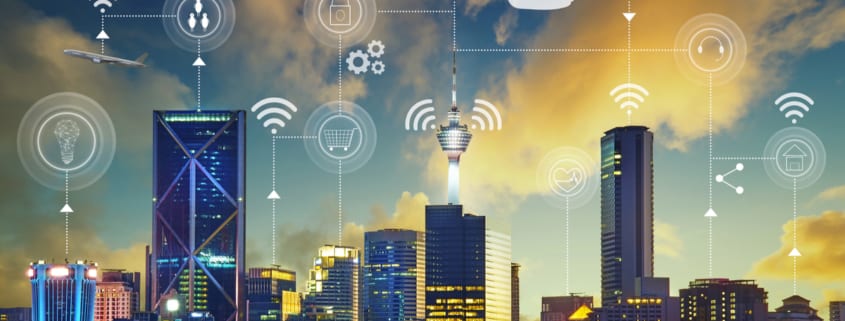Why Office Buildings are Adapting to The Smart Building Trend
According to a report produced by Zion Market Research, the global smart building market was valued at approximately $7.0 billion in 2014 and is expected to reach approximately $36 billion by 2020. There are various factors that contribute to the growth in the smart building market including the rapid rate of urbanization worldwide, low operating costs, favorable government regulations, and the crucial role that smart buildings play in energy conservation.
As more and more commercial real estate professionals begin to gravitate towards technology, smart office buildings are becoming a more widely adopted method for companies to meet the needs of their occupants while ensuring that each dollar spent on the office space is optimized.
What is a smart building?
A smart building is any structure that uses automated processes to control a building’s operations, including heating, ventilation, air conditioning, lighting, and security. The data that is collected by smart buildings helps businesses gather information that can be used to improve a building’s performance and efficiency. These buildings also provide occupants with additional opportunities to become more productive during the workday.
Why are offices adapting to this trend?
The design of today’s office buildings has drastically evolved from the traditional gray cubicles that once dominated these spaces. Instead, smart buildings with features including optimized HVAC systems, smart sensors for lighting, and controlled appliances from remote locations. These intelligent buildings create environments that help employees focus, leading to increased productivity, output, and happiness, while also increasing energy efficiency and office space utilization.
Tenant Demands
As the modern tenant relies more and more on technological devices, their expectations for connectivity have transferred to the places where they work. Businesses that want to remain relevant understand the need to cater to tech-savvy employees who desire workspaces with the latest technology. While a large portion of employees want and expect offices to have these types of features, according to a study by Dell and Intel, 44% of office workers worldwide believe that their offices are not smart enough.
The CCIM Institute found that “the majority of smart innovations have occurred in the office segment, primarily in large markets’ central business districts”. And as smart office buildings continue to gain momentum, new demands for an office’s digital infrastructure will continue to rise. However, as of 2017, only 15% of commercial buildings are smart buildings. Owners of smart buildings have an advantage when it comes to attracting tenants who are looking for offices that are equipped with strong technology infrastructure. These technology-seeking tenants are typically willing to pay higher rents for these types of offices, leading to a potential increase in ROI.
Energy Efficiency
The average office building can expect to save 18% of its total building energy use simply by adapting to smart technologies. Even smaller offices can expect to see around the same amount of energy savings as their larger counterparts by using these technologies. Although each office building uses different amounts of energy for a variety of reasons, lighting, HVAC systems, and office equipment are three areas where smart building technology can be used to extract the greatest impact.
According to the Carbon Trust, 40% of a building’s electricity usage comes from lights. Smart buildings with LED lighting can see savings of up to 95% of their total usage. HVAC systems account for 39% of energy used within commercial real estate buildings in the United States. By simply installing occupancy-based thermostats that are programmed to operate even when the building is vacant, businesses can save anywhere from 5-10% of HVAC related energy costs. According to ACEEE, the American Council for an Energy-Efficient Economy, office equipment accounts for 7%, or $1.8 billion, of total commercial electricity costs. Smart building technology can be used to reduce this percentage, making the cost of using office equipment more economical.
Because existing buildings account for more energy use than new spaces, many commercial building owners have begun retrofitting older buildings to reduce their energy footprints. As a result, sustainability is typically one of the main focuses of office building retrofitting. Also, more sustainable buildings can attract higher-paying tenants, resulting in a greater appreciation of the building’s value.
Space Utilization
Space utilization, the measure of the number of employees at work (in offices, workstations & conference rooms) at any given time during the workday, has become a major factor in offices adapting to the smart building trend. On average, office spaces cost $43.79 per square foot per year with an upward mobility of about $70 per square foot depending on location. According to a report by CBRE, about 40% of office space within the United States is empty. With a significant amount of space being underutilized or completely unused, many companies are paying for more space than they actually need.
There are a number of factors that have contributed to the growing percentage of underutilized office space. For example, increases in the number of freelance employees, coworking spaces, laptop and mobile phone technology, and remote access to work files have made it possible to be productive even outside of the office.
The goal for many organizations is to attract and retain top talent by offering access to collaborative and creative spaces. They are typically seeking the most economical way to provide employees with desirable amenities without increasing overhead costs. Smart building technology is capable of collecting data about which spaces within an office are being used throughout the day as well as the frequency of that utilization, helping to prevent companies for over-paying for unnecessary space so that they can better achieve this goal.
To learn more about the future of the workplace, read Workplace of the Future: Challenges, Trends, and Implications for Modern Office Spaces.











